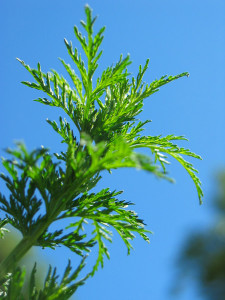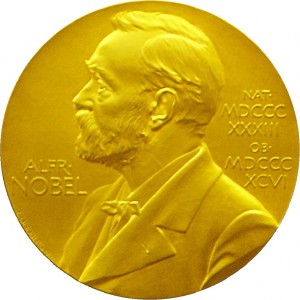The Nobel Assembly at Karolinska Institutet awarded the 2015 Nobel Prize in Physology & Medicine earlier this month. The honors went to the scientists who discovered artemisinin and avermectin, which respectively treat malaria and parasitic infections. We’ll explore ivermectin in another post, but today let’s talk artemisinin!
Chemistry of artemisinin
Artemisinin is a sesquiterpene lactone compound that contains an endoperoxide bridge – a functionality biochemists are unaccustomed to seeing, but is believed to be essential for the drug’s anti-malarial activity. The drug is the fastest treatment available for malaria cause by the parasite Plasmodium falciparum.

The structure of artemisinin. Note the lactone in the lower portion of the molecule above, and the peroxide bridge -O-O- in the top left portion.
Artemisinin is biosynthesized by the plant Artemisia annua, or sweet wormwood. The plant is native to China and Vietnam, but is also grown in East Africa. When the plants reach full size after about 8 months of growth, the leaves are dried and then artemisinin is extracted by organic solvents, with hexane usually being the solvent of choice.

Leaves of Artemisia annua.
Semi-synthetic pathways to artemisia also exist. Genetically engineered yeasts can produce artemisinic acid, a precursor to artemisinin. Artemisinic acid can then be purified and further modified synthetically to yield artemisinin. Scientists have also engineered tobacco plants to produce artemisinic acid.
Mechanism
How artemisinin works is hotly debated. The likeliest mechanism involves radical formation by the endoperoxide bridge. In this mechanism, iron from the heme in blood reduces the peroxide bond in artemisinin, producing an iron-oxo species. This iron-oxo species leads to to a series of reactions that generate radical oxygen species that kill the parasites causing malaria. Experiments show that exposure to artemisinin leads to damage in parasites’ vacuolar membranes, and that the compound is present in the Golgi, endoplasmic reticulum, and mitochondria of P. falciparum after exposure.
Discovery
In 1967, Tu Youyou led a Chinese research program to find a treatment for malaria as mandated by Chairman Mao. After scouring the historic literature, for homeopathic and folk remedies to malaria symptoms, Tu Youyou stumbled across a recipe for extracting Artemisia annua in The Handbook of Prescriptions for Emergency Treatments written in 340 BC . After modernizing and improving the extraction prtocol, Tu Youyou discovered the extract was indeed anti-malarial. And upon purification artemisinin, which is named qinghaosu in Chinese, was the compound responsible for its activity. The results of his research were published in the Chinese Medical Journal in 1979.
So, that’s artemisinin in a nutshell. Artemisinin has saved countless lives world-wide. It is typically used in combination therapies these days. But even so, malaria still is estimated to kill over 1 million people each year.



